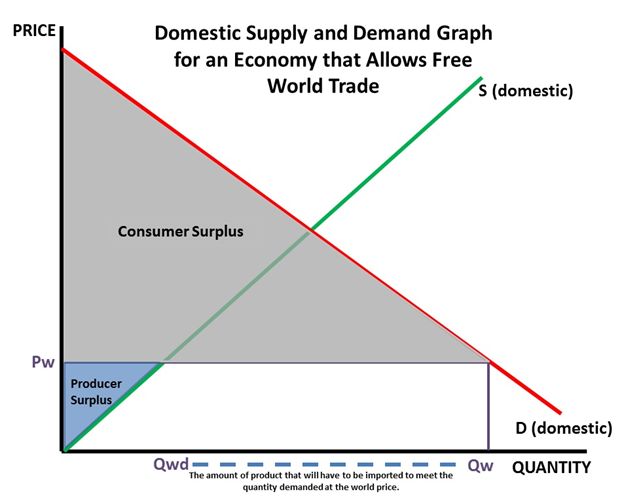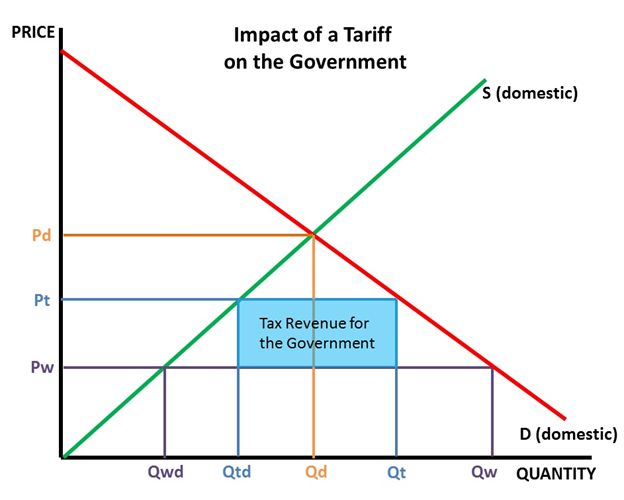Learn
|
NAFTA, short for North American Free Trade Agreement, was a major agreement the United States entered into in the mid-1990s. There was plenty of emotion from those who supported and opposed the agreement. The benefits and costs of NAFTA are still brought up in election cycles as politicians promise to protect American jobs. Read NAFTA: Are Jobs Being Sucked Out of the United States? to learn more about NAFTA. Although you are not responsible for any of the charts or questions, they will help you understand, so read the material carefully. Pay particular attention to what the article claims is the actual outcome of NAFTA. After WWII many nations of the world came together to discuss the reduction of tariffs and trade restrictions that were prominent throughout the world. The agreement that came out of this gathering was the General Agreement on Tariffs and Trade (1947). GATT was a monumental effort by the participating nations to increase trade around the world. GATT was replaced by the World Trade Organization in 1995, but the framework for GATT is the basis for the WTO. You will look at a real-world problem concerning the production of bananas to see why this organization was created. Read The Guardian: The banana wars explained to learn about the issues and who is involved in the arguments about bananas. Then, go to About WTO and read the material under the following links:
You will see that free trade is not a cut-and-dried issue. The organization looks at all the facts surrounding trade between nations and must make objective decisions in an attempt to be fair. With a basic understanding of the terminology of free trade, we will now look graphically at the winners and losers associated with free trade. We will first look at the domestic supply and demand graph for any product. Look at the graph below. Watch Domestic Supply and Demand Graph for a Closed Economy (1:38) for an explanation of the graphs used in this section. Video transcript
We will look at a closed economy. A closed economy does not trade with any other nation. Without trade what will be the equilibrium price and quantity for this good? In the graph above: Price = Pd Quantity = Qd This price and quantity represent the intersection of the domestic supply and demand curves. You will now be introduced to the concepts of consumer surplus and producer surplus to help us analyze free trade. The basic idea is that you feel like you have been given a bargain for many items you buy because you know that you were willing to pay more to get the item. A business gets the same feeling because many realize they would have been willing to sell you the item for a lower price. The area of consumer surplus is represented by the area between the Demand line and the price line. In the chart above, the consumer surplus is shaded a light purple color. The area of producer surplus is represented by the area between the Supply line and the price line. In the chart above, the producer surplus is shaded a light yellow color. Use the baseline price of Pd, quantity Qd, consumer surplus, and producer surplus to see the effects of free trade, tariffs, and quotas. Watch Free Trade (2:10) for an explanation of the graph below. Video transcript
Look at the graph above. The domestic demand and domestic supply will stay the same with free world trade. The most important item to consider is the price. If the world trade price is lower than domestic price according to the Law of Demand, consumers will want to purchase more, while the Law of Supply says that producers will want to make less product. We will assume that the world price is represented by Pw. If you follow the Pw line straight across, you see that it crosses the Domestic supply line first. Domestic suppliers will only supply Qwd. Continue to follow the Pw line until it crosses the domestic demand line. The Pw line intersects the demand line at Qw. Domestic suppliers cannot meet the quantity demanded at the lower prices. The distance between Qw and Qwd will be the amount of product that will have to be imported to meet the quantity demanded at the world price. Look at the changes in consumer and producer surplus to see the change in world trade. Since consumer surplus is the area from the demand line to the price line, we see that with world trade, consumer surplus is now represented by the area shaded in gray. Look at domestic Producer Surplus from the Pw line to the supply line. Producer surplus is now represented by the area shaded in blue. In summary, when changing to free trade, the winners include the foreign producers who are now able to sell their products abroad. Other big winners are the domestic consumers who see their consumer surplus increase. The biggest loser in free trade will be the domestic producers as they see their surplus shrink. What this means specifically is that domestic suppliers of goods that are now having to compete with foreign producers will have to cut back their production or even go out of business. Watch Quotas and Tariffs (3:03) for an explanation of the graph below. Video transcript
Look at the graph above. Some domestic producers will lobby the government to place a quota or tariff on imports to combat the competition from free trade. A tariff or quota has the effect of increasing the price from Pw to Pt. By looking at the graph, we can see what changes take place in the market for this good. By following the Pt line across, you will see that domestic suppliers can now increase their production from Qwd to Qtd. This follows the law of supply which says that with an increase in price suppliers will supply more. Continuing to follow the Pt price, you will see that domestic consumers will now decrease their purchases from Qw to Qt. Foreign producers will import the difference from Qt to Qtd. Identifying the consumer surplus between the Pt line and the demand line, we see that consumer surplus with a tariff or quota is now reduced to the area shaded green. Identifying the domestic producer surplus between the Pt line and the supply line, we see that producer surplus has now increased to the area shaded pink. The winners with a tariff or quota are the domestic producers since their surplus has now increased. The losers with a tariff or quota are domestic consumers and foreign producers. Domestic consumers will now pay a higher price for less product. Foreign producers will lose because they are limited in the revenue they can earn. With free world trade, the revenue earned by foreign companies is represented the area that is shaded gray. With a tariff or quota, their revenue is now limited to the area designated by the blue arrow. Watch Impact of Tariffs on Government (1:42) for an explanation of the graph below. Video transcript
Look at the graph above. The last entity to look at is the government. The government is not affected either way with a quota since the product from foreign nations is simply limited. The government will gain by establishing a tariff. The government will receive additional revenue with a tariff. In this case the revenue they receive will be the size of the tariff, which is Pt - Pw, multiplied by the amount of goods that are imported, which is Qt - Qtd. The tax revenue for the government is represented by the area that is shaded blue. The basic difference for the government is that they will receive revenue from a tariff but not from a quota. With the use of supply and demand graphs, it is easy to see the winners and losers in an open economy and a closed economy. In a closed economy, consumers will pay the most and have the least quantity, while domestic suppliers will earn the most money and make the most quantity. In a completely open economy, consumers will pay the least while domestic producers will lose the most. The idea of domestic producers losing their jobs is harsh; however, remembering the article on NAFTA, those domestic employees can now apply their resources to a job that is more efficient, all other things being equal. If you need to review the graphs from this lesson, watch the compiled review video below. Video transcript
Should we really always "buy American"? In this interview with Fox News' John Stossel, economist David Henderson argues that we should buy the cheapest goods available to free up capital for further spending. Watch "Buy American" is Nonsense. While watching the video, think about the following questions:
|



